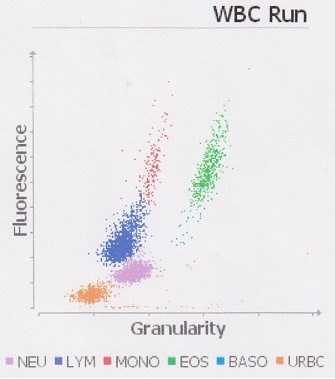Contact
Inger Lilliehöök
Professor at the Department of Clinical Sciences; Clinical Pathology Unit
Telephone: 018-671616
E-mail: inger.lilliehook@slu.se

Erroneous neutrophil and lymphocyte counts from analysis of feline blood samples were transferred directly into the hospital information system from the ProCyte Dx hematology instrument in our after-hours laboratory. Errors usually were not detected by the users.
Hypothesis/Objectives:
To quantify the frequency and severity of errors associated with the ProCyte Dx analyzer and to identify methods to avoid the errors.
Animals:
One-hundred six EDTA blood samples routinely submitted from feline hospital patients were analyzed.
Methods:
ProCyte differential leukocyte counts were compared to 2 reference methods: Advia 2120 hematology instrument and manual enumeration. Limits for unacceptable deviation from the reference methods were defined as 18 for % lymphocytes and 23 for % neutrophils.
Results:
Fourteen of 106 samples had unacceptable errors for both lymphocytes and neutrophils compared to both reference methods. Median % lymphocytes in those 14 samples were 11.2, 15.0, and 53.0% for Advia, manual, and ProCyte, respectively. Median % neutrophils were 85.4, 81.5, and 34.2% for Advia, manual, and ProCyte, respectively. All errors were avoided by rejecting automated ProCyte differential leukocyte results whenever the dot plot appeared clearly incorrect, but only 9 of these 14 samples had a ProCyte WBC distribution error flag.
Conclusions and Clinical Importance:
Results reported by ProCyte had markedly falsely increased lymphocyte and decreased neutrophil counts in 13% of feline patient samples. Users must reject automated differential leukocyte count results when the WBC dot plot appears overtly incorrect. Rejection based only on ProCyte WBC error flag was insufficient.
http://onlinelibrary.wiley.com/doi/10.1111/jvim.14815/epdf
Tvedten HW, Andersson V, Lilliehöök IE. Feline Differential Leukocyte Count with ProCyte Dx: Frequency and Severity of a Neutrophil-Lymphocyte Error and How to Avoid It. J Vet Intern Med vol 31, issue 6, nov/dec 2017, p 1708-1716. doi: 10.1111/jvim.14815.
Inger Lilliehöök
Professor at the Department of Clinical Sciences; Clinical Pathology Unit
Telephone: 018-671616
E-mail: inger.lilliehook@slu.se